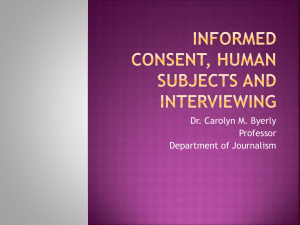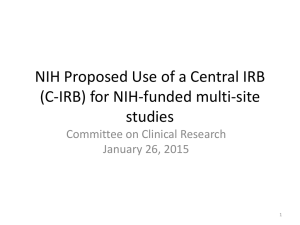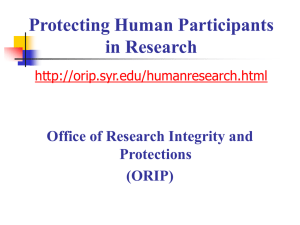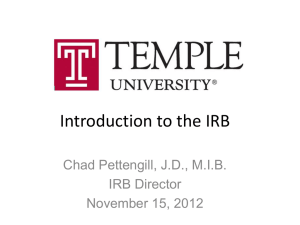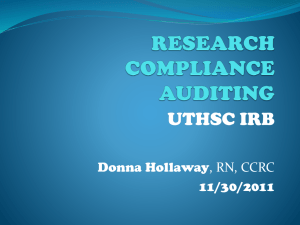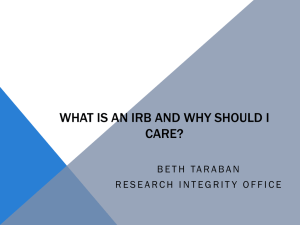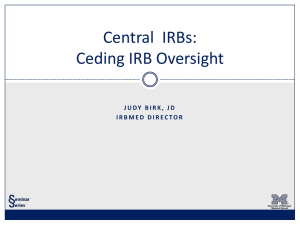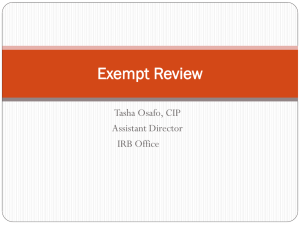2013 CTE Symposium presentation on SEU IRB
advertisement
Research in the classroom and beyond- A comprehensive review of IRB policies and procedures Steven Fletcher and Sara Villanueva CTE Teaching Symposium August 22nd, 2013 The Purpose of this forum…. • Learn what questions you have (5 min) • Address common tips for successful IRB submission (15 min) • Preview new IRB website and submission process (15min) • Answer any questions you have (15 min) Pre-activity • Take a moment to jot down any questions or concerns you have about working with the IRB on research here at SEU. • Turn to a colleague and share your thoughts. • Share out. St. Edward’s University IRB Members 2013-2014 IRB committee Leadership. Chair: Steven Fletcher, Vice-Chair: Sara Villanueva School reps. Kelly Green, James Kallman, Henry Altmiller, Joel Bergh, Bob Strong Stephanie Martinez, Shannan Butler, Elizabeth Katz, Sunny Landsdale OSP. (ex officio) Gloria White Admin. (ex officio) Sandra Pancheco Consultant. David Blair Institutional Review Board IRB Review • The purpose of IRB review is to maximize research participant benefit and minimize risk. • Using the information in the protocol submission documents, the IRB reviewers weigh the benefits of participation against researchrelated risks for the prospective research subjects. 8 tips for success 1. 2. 3. 4. 5. 6. 7. 8. Complete submission Clarity in description of proposal Information consistency Strong data security measures Research team member roles and responsibilities are clearly described. Well defined research design Research related activities are clearly described Submitted documents are “research-ready.” Does my research require IRB review? No Does the study involve human subjects? Yes Is there any potential for psychological or physical harm to those participating in the study? Yes No Is there any chance that confidential information will be disseminated? Yes No Will participants be coerced or in any way unable to legally give consent? Yes No Does the study involve any vulnerable populations such as children, pregnant women, mentally disabled, institutionalized persons, or prisoners? Yes No Is there any chance that the results will be published or presented outside of the classroom setting? Yes No NO your research study does not require IRB review. YES your research study requires IRB review. For complete information on IRB policies and proceedures visit: http://academic.stedwards.edu/irb/reviewprocess Levels of Review: Exempt Exempt Research: Although the category is called "exempt," this type of research does require IRB review and registration. To qualify, research must fall into six (6) federally-defined exempt categories. These categories present the lowest amount of risk to potential subjects because, generally speaking, they involve either collection of anonymous or publicly-available data, or conduct of the least potentially-harmful research experiments. Some examples of Exempt research are: • anonymous surveys or interviews • passive observation of public behavior without collection of identifiers • retrospective chart reviews • analyses of discarded pathological specimens without patient identifiers. Levels of Review: Expedited Expedited Research: To qualify for an expedited review, research must fall into nine (9) federally-defined expedited categories. These categories involve collection of samples and data in a manner that is not anonymous and that involves no more than minimal risk to subjects. • Some examples of expedited research are: • studies involving collection of hair, saliva or dental plaque samples, • studies of blood samples from healthy volunteers, • analyses of voice recordings • studies of existing pathological specimens with patient identifiers. Expedited review as defined by federal regulations allows the IRB chairperson or one or more experienced reviewers designated by the chairperson from among members of the IRB to evaluate and approve specific types of research. Reviewers conducting an expedited review may exercise all of the authority of the IRB except that they may not disapprove a study. When a subcommittee cannot approve the research under expedited review, the study is referred to the full Committee for review. Levels of Review: Full Board Full Committee Review: Proposed human subject research which does not fall into either the exempt or expedited review categories must be submitted for full committee review. This is the most rigorous level of review and, accordingly, is reserved for research projects that present more than minimal risks to subjects. Navigating through the IRB website http://academic.stedwards.edu/irb #1: The complete submission • • When required information is missing from the initial IRB submission, the IRB staff will contact the researcher with requests for additional pieces of information. The IRB will not distribute an incomplete protocol to committee members for review. Carefully review your institution’s submission checklist and make sure that all required elements are included with the protocol submission a) Description of the informed consent process b) Letters of informed consent / assent c) Letters of cooperation / agreement d) Recruitment materials e) Verification of Human Subjects’ Protections Training f) Data collection tools a) Informed consent / Assent process elements WHO will be responsible for obtaining the informed consents? WHO will answer the prospective participants questions about the research study? WHERE will informed consent take place? WHAT information will be provided to each participant? HOW will participants receive information about the study? HOW will the members of the research team verify that participants understand the essential informed consent elements? WHEN will the participants provide their informed consent? b) Informed Consent document elements Include all of the required elements on the informed consent document. Provide the IRB with an exact copy of all consent / assent documents. After the IRB has approved the protocol, any & all changes to the letter of informed consent must be submitted as a project “revision” for approval. Develop the Informed Consent document on institutional letterhead. d) Recruitment Materials Provide the IRB with exact copies for all recruitment documents & scripts (e-mails, phone scripts, announcement postings, inperson announcement scripts, etc). Provide the IRB with detailed information about your recruitment procedures and strategies. d) Required recruitment elements 1. 2. 3. 4. 5. 6. 7. Name and address of the researchers and the research facility Purpose of the research Eligibility criteria for participation Anticipated participant benefits (if any) Time or other commitments required of the participant Location of the research Individual to contact for additional information Resource Recruiting Study Subjects, United States Food and Drug Administration (FDA). e) Ethics training Provide the IRB with verification of human subjects protections training for all members of the research team (CITI training). Resource OHRP Investigator Responsibility Frequently Asked Questions, United States Department of Health and Human Services (DHHS). f) Data Collection Tools & Measures • Provide the IRB with all study-related tools, measures, surveys, and data recording forms. The IRB must receive these tools and measures in the exact form that they will be used in the research and distributed to the research participants. • If participants will be accessing a survey or other measures electronically (ie. from an online survey hosting service), provide the IRB with a live link to the online survey. Tip #2: Clarity of Submission The protocol should include a clear explanation &/or description of all research process elements If the information provided by the researcher is confusing or unclear, the IRB will contact the researcher with requests for clarifications. • Significant and distracting grammar errors that result in unclear communication • Spelling errors and lack of precision with “word choice” • Missing, confusing &/or inaccurate information • Use of jargon Tip #4: Protocol Consistency The description provided for participant research related activities should be consistent across all protocol documents – – – – – Protocol description of research activities Informed consent document(s) Protocol description of informed consent processes Recruitment materials Letter of cooperation/agreement When the information provided in the protocol is contradictory &/or inconsistent, the IRB is unable to evaluate participant risks and benefits. #4: Common Inconsistencies The amount of time required for study participation is not the same on all study-related documents. Example: Identifies in the protocol that the focus groups will meet for 90 minutes; identified in the letter of consent that the focus groups will meet for 60 minutes. The number of individuals needed for research study participation is not the same on all study documents. Example: Identifies a projected sample size of 50 participants in the protocol; identifies a projected sample size of 65 on the letter of informed consent. #4: Common Inconsistencies • The words anonymous and confidential are used interchangeably. – Anonymous means that there is no link between the participants and the data they provide. – Confidential means that there is a link between participants and the data they provide. Example: Describes a procedure for coding data that includes using a key to link individual participants to the information they provide on a survey document; States on the letter of informed consent that the method of data collection is anonymous. #4: Common Inconsistencies Once involved in the research process, participants are asked to provide personal information beyond the scope of what was described during the recruitment process or during informed consent processes. Example: Participants are informed that they will be completing a functional assessment tool for range of motion. After signing the letter of informed consent, participants are asked to provide information about their workman’s compensation status. Tip #4: Data security Specific IRB Concerns • Data security measures are insufficient for the type of data collected. • Procedures for data storage, retention, and security are not described. • Procedures for data storage, retention and security are not appropriate for the type or format of the data. • Procedures for data coding (if performed) are not addressed or insufficiently described. • Does not include sufficient data security strategies for protecting the data “key” (the information that matches the participant identifiers to the coded data). Tip #5: Research Team Member Responsibilities & Qualifications To ensure that participant risks are minimized, investigators must provide evidence that they are sufficiently qualified to perform their research-related tasks and responsibilities. If information about the researchers’ qualifications &/or credentials is unclear, the IRB will ask the investigators to provide this data. Tip #8: Strong research design • The relationship between the current study and previous research is clearly established. • The links between the research questions (hypotheses statements); the research design; the specific types of data collected; the data collection tools or measures, and the data analysis procedures are clear, consistent, &/or accurate. • The link between the type of research methodology (grounded theory, ethnography, focus group, etc.) and specific research procedures is clearly described. • Rationale for collecting specific pieces of personal information is provided. • Rationale for sample size is provided. Considerations of Research Design IRB Guidebook, Chapter 4 • The value of research depends upon the integrity of study results. For example, one of the ethical justifications for research involving human subjects is the social value of advancing scientific understanding and promoting human welfare by improving health care. But if the research study is so methodologically flawed that little or no reliable information will result, it is unethical to put subjects at risk or even to inconvenience them through participation in such a study. • One question that every IRB member asks is "To what degree is it our responsibility to review the underlying science of the proposed research?" Clearly, if it is not good science, it is not ethical. Tip # 7: Clear description of the research activities Clear and complete information provided about the research-related activities or interventions helps the IRB evaluate participant risk. If the description of the research activities is insufficient or unclear, the IRB will ask the researcher to provide additional clarifying information. Clearly Describe All Research-Related Activities Where will the research be conducted? Which members of the research team are involved in each procedure? What will each participant in the research study do? How long will each research-related activity take? What are the risks associated with each activity? What are the specific participant benefits associated with each activity? Tip # 8: Research-Ready Documents • Documents must be research-ready: If post-IRB approval changes to the letters of informed consent/assent and/or recruitment materials are needed, a “Request for Revisions” must be submitted to the IRB for approval before these documents can be used in the research process. • Active links to electronic surveys. • Appropriate documents on letterhead. • If survey data collection is anonymous or if there is an intention to code the survey data, remove from the survey documents requests for the participants’ names and significant identifying information. IRB Resources Much of the information in this presentation was adapted from a 2010 University of Indianapolis IRB forum. The standards for IRB review are derived from Code of Federal Regulations Title 45 Public Welfare Part 46 Protection of Human Subjects (45 CFR 46). A good resource for information about the IRB review process standards is the Office for Human Research Protections (OHRP) IRB Guidebook IRB Guidebook Chapter 3, Basic IRB Review: Includes information about informed consent, selection of subjects, privacy, & incentives. IRB Guidebook Chapter 4, Considerations of Research Design IRB Guidebook Chapter 5, Biomedical and Behavioral Research A comprehensive source of information about IRB guidelines and processes: Bankert, E. & Amdur, R. (2005). Institutional Review Board: Management and Function, Jones & Bartlett.

